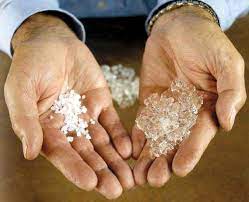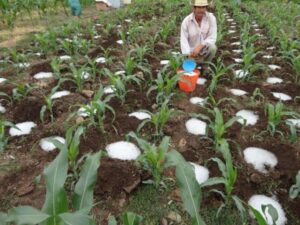Solid Rain, they are like sugar grains, polymers, expand and capture 400 times their weight in water, and transform into a gel that aims to address the water scarcity affecting 60% of Mexico’s territory.
According to Leonardo Rico, creator of Solid Rain along with his father in 2007: “Initially, the idea was to find an alternative on how to save water in agricultural irrigation. We know that there are other irrigation systems such as sprinkler and drip irrigation that are more efficient than conventional irrigation, but still, a certain percentage of water is wasted due to evaporation and infiltration. So, we evaluated another alternative that could exist, and it arose from a very simple beginning like a disposable diaper.”

Unlike hydrogel, this polymer is made from potassium that nourishes the soil and allows better trapping of water molecules.
They founded the company in 2012 and their innovation has been adopted by 4000 producers throughout the country.
Solid Rain multiplies the crop yield, germination, and survival. The roots absorb the water they need, and the granular powder can last from 6 to 8 years.
“And this bit of water, as it is released, becomes smaller. In order to return to its original form, which is the granules. And when it is watered again. Or when it rains again, it hydrates again and the process is repeated for several years, which is the life span of Solid Rain,” says Rico.
An innovation that is being tested in this backyard crop. Marcos León is the distributor of Solid Rain in Hidalgo, a state in the heart of Mexico.
Marcos, an agronomist, believes that this irrigation system will help reduce water overexploitation that has dried up aquifers in this semiarid region.
Half of the municipalities in Hidalgo suffer from extreme drought
Joana, one of the students doing her social service in this experimental plot, has experienced it. Her family still uses rudimentary irrigation methods, and their fields have become exhausted.
Corn requires 500 to 800 mm of annual precipitation, and in the area, only 430 mm fall. This technology has surprised her and encouraged her to adopt it in her community.
 Mexican farmer using Solid Rain[/caption>
Mexican farmer using Solid Rain[/caption>
“Especially in my family, we still maintain traditional methods, with furrow irrigation, automated irrigation systems are not yet widely implemented, but technologies like Solid Rain are a great benefit. I think it is very important because we would reduce water consumption,” says Joana Bárcena, a family agriculture student.
Water savings with Solid Rain range from 70 to 90%
It depends on the type of crop and the amount of water applied, although the initial investment may seem high, it is recovered in the first agricultural cycle.
Despite its benefits, Solid Rain has encountered significant resistance among farmers to abandon their lifelong practices.
The first farmer who implemented Solid Rain
The first to take the step was Amado Magos on his hectare of corn. He buried polymers next to the seeds in 24 rows. As that portion of land was much more resistant, it provided more fodder with more cobs, more nutrients, ultimately more productive. This farmer depends on a good harvest for his family’s livelihood.
“There was indeed a tremendous difference, I would say, comparing it to when the plant did not have Solid Rain, it suffered from considerable drought stress, the top of the plant appeared normal. So, yes, sometimes we talk about a difference from zero to 8 days that can allow us to have a drizzle or water, which would help the plant achieve its goal,” comments Amado Magos, a corn producer.
In Hidalgo, 4 out of 10 households live in poverty
In the municipality of Huichapan in Hidalgo, 4 out of 10 households live in poverty. Drought has hit these communities of small producers, who have also suffered from institutional abandonment. None of the state or federal governments have promoted a strategy for accessing and managing water. This is acknowledged by the Ministry of Agriculture itself.
“Although this irrigation system wastes a large amount of water, we do not have a specific water plan to capture and store water, and the water from the aquifers we are extracting does not have much infrastructure, it is very old,” acknowledges Julio Orapeza, a technician at the Ministry of Agriculture.
Solid Rain was born with the social interest of supporting corn, bean, or wheat farmers, the humblest ones. Most of them do not have the resources to adopt it.
The strategy for everyone to access Solid Rain
Most of them do not have the resources to implement this innovation</strong

